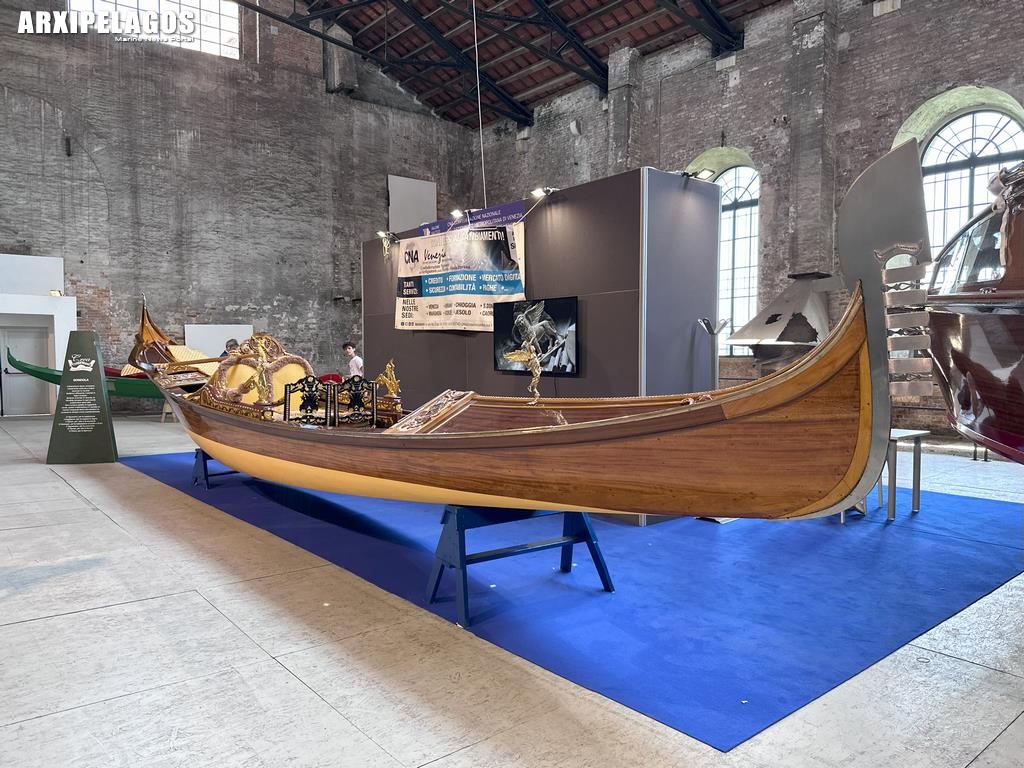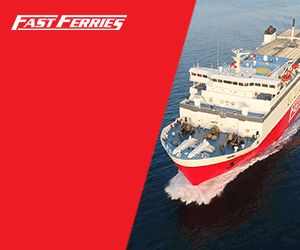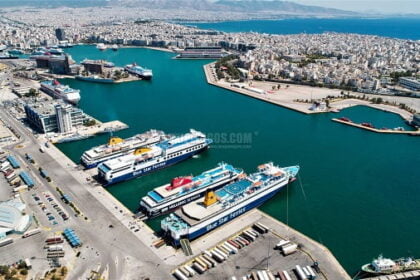(The article is followed by separate article in English)
Η Βενετία εκτός από ιδιαίτερα γραφική, είναι μια πόλη που έχει μεγάλη ναυτική ιστορία από το ένδοξο της παρελθόν. Εκεί λοιπόν διοργανώθηκε φέτος το σημαντικό διεθνές Ναυτικό Σαλόνι της Βενετίας, Salone Nautico Venezia 2023, από τις 31 Μαΐου έως τις 4 Ιουνίου. Στο μεγάλο Ναυτικό Σαλόνι της Βενετίας παρουσιάστηκε για πρώτη φορά παγκοσμίως στο ευρύ κοινό, το διεθνές project Enduruns το οποίο χρηματοδοτείται από την Ευρωπαϊκή Ένωση μέσω του προγράμματος Horizon 2020 και την Κορεατική κυβέρνηση και αφορά στην ανάπτυξη και επίδειξη ενός ηλεκτρικού αυτόνομου μη επανδρωμένου σκάφους επιφανείας USV σε συνδυασμό με ένα μη επανδρωμένο βαθυσκάφος. Και τα δύο σκάφη μπορούν να τροφοδοτούνται ενεργειακά από κυψέλες υδρογόνου εκτός από τις μπαταρίες λιθίου που έχουν εγκατασταθεί.
Η αποστολή του Arxipelagos.gr αποδέχτηκε την πρόσκληση του Καθηγητή της Σχολής Μεταλλουργίας και Υλικών του Πανεπιστημίου του Birmingham κ. Μαγιορκίνου Παπαηλία, ο οποίος είναι ο Επιστημονικός Συντονιστής του project και ταξίδεψε στη Βενετία για να παρουσιάσει σε οπτικοακουστικό υλικό το πρωτοποριακό έργο.
Το πρωτότυπο μη επανδρωμένο σκάφος επιφανείας USV έχει σχεδιαστεί για να λειτουργεί ως μητρικό σκάφος υποστήριξης για το υβριδικό βαθυσκάφος AUV, το οποίο εξέρχεται από κρύπτη με ειδικό μηχανισμό που βρίσκεται στο πρυμναίο τμήμα του USV, κατά την έναρξη μιας αποστολής. Το σκάφος επιφανείας κινείται με ηλεκτρική ενέργεια, καθώς οι μπαταρίες λιθίου φορτίζονται από τα φωτοβολταϊκά πάνελ και τις κυψέλες υδρογόνου. Με τη βοήθεια του ακουστικού μόντεμ που βρίσκεται εντός του σκάφους, το USV αλληλεπιδρά με το βαθυσκάφος με αποστολή και λήψη δεδομένων. Μέσω του δορυφορικού συστήματος που διαθέτει το σκάφος, πραγματοποιείται ο τηλεχειρισμός του από το απομακρυσμένο κέντρο διοίκησης και συντονισμού, καθώς επίσης μπορεί να αποστέλλει σε πραγματικό χρόνο εικόνες, μετρήσεις και παραμέτρους της αποστολής που επιχειρεί. Η κατασκευή του αποτελείται από υαλονήματα fiberglass και είναι εξαιρετικά ανθεκτική για δυσμενείς συνθήκες θάλασσας και αέρα. Έχει 9 μέτρα μήκος και 2 μέτρα πλάτος. Το μικτό βάρος είναι 4,5 τόνοι και το απόβαρο 3 τόνοι. Διαθέτει δύο τιμόνια, ενώ η πρόωσή πραγματοποιείται με δύο ηλεκτρικές προπέλες που βρίσκονται εμπρός από τα τιμόνια.
Το πρωτότυπο μη επανδρωμένο βαθυσκάφος AUV έχει σχήμα τορπίλης και έχει τη δυνατότητα να εξέρχεται και να εισέρχεται στο μητρικό σκάφος USV. Μπορεί να καταδύεται έως τα 6.000 μέτρα βάθος, εφόσον η κατασκευή του αποτελείται από τιτάνιο, ενώ για βάθη έως 1000 μέτρα μπορεί να χρησιμοποιείται κράμα αλουμινίου ως υλικό κατασκευής. Οι δυνατότητες του στο θαλάσσιο βυθό είναι πολλαπλές και περιλαμβάνουν ένα ευρύ φάσμα εφαρμογών, όπως χαρτογράφηση βυθού υψηλής ανάλυσης, γεωλογικές και γεωφυσικές έρευνες, επιθεώρηση υπεράκτιων κατασκευών, επιτήρηση και ανάλυση χημικών συστατικών κ.α. Οι ενεργειακές του ανάγκες καλύπτονται από κυψέλες καυσίμου υδρογόνου και μπαταριών λιθίου. Οι μπαταρίες λιθίου μπορούν επίσης να επαναφορτίζονται αυτόματα όταν βρίσκεται εντός του μητρικού σκάφους USV. Έχει 6 μέτρα μήκος και 60 cm διάμετρο. Το βάρος του εκτός νερού είναι 900 kgr. Η πρόωση πραγματοποιείται με 4 ηλεκτροκίνητες προπέλες. Δύο πτερύγια που διαθέτει στο πρυμναίο τμήμα, βοηθούν στην αλλαγή βαθών στη θάλασσα με ελάχιστη χρήση ενέργειας.
Η ενέργεια που παρέχεται στα δύο ειδικά θαλάσσια οχήματα USV και AUV είναι απόλυτα φιλική προς το περιβάλλον και συμβάλει στην προστασία του πλανήτη. Μέσω ειδικών ρυθμίσεων που αποστέλλονται από το απομακρυσμένο κέντρο συντονισμού, τα δύο θαλάσσια οχήματα έχουν τη δυνατότητα να μειώνουν στο ελάχιστο την κατανάλωση ενέργειας, συμβάλλοντας σημαντικά στην εξοικονόμηση της, χωρίς να επηρεάζεται η αποστολή. Το Project ENDURUNS σηματοδοτεί το μέλλον των ερευνών στους ωκεανούς και τις θάλασσες του πλανήτη και φανερώνει παράλληλα τη διεθνή τάση της ναυτιλίας στην αναζήτηση χρήσης φιλικών προς το περιβάλλον και ταυτόχρονα οικονομικών πηγών ενέργειας.
Λίγο καιρό μετά την ολοκλήρωση του μεγάλου διεθνούς σαλονιού της Βενετίας, η αποστολή του Arxipelagos ταξίδεψε ξανά στην όμορφη πόλη του ιταλικού βορρά, για να καταγράψει σε οπτικοακουστικό υλικό τα πρώτα δοκιμαστικά των θαλάσσιων οχημάτων στη θάλασσα, σε πραγματικές συνθήκες έρευνας. Δείτε παρακάτω τα σχετικά βίντεο. Επίσης παρακολουθήστε την on camera συνέντευξη που μας παραχώρησε ο Επιστημονικός Συντονιστής του project, κ. Μαγιορκίνος Παπαηλίας, Καθηγητής στο Πανεπιστήμιο Birmingham, καθώς και την on camera παρουσίαση των θαλάσσιων ειδικών οχημάτων AUV και USV, κατά τη διάρκεια της έκθεσης τους στο Ναυτικό Σαλόνι της Βενετίας 2023.
Venice apart from being extremely beautiful, is a city with a great naval tradition and a glorious past. This year, Venice hosted the Nautical Salone of Venice 2023, Salone Nautico Venezia 2023, from 31st of May to 4th of June. In the great Salone Nautico Venezia 2023, the international project ENDURUNS was exhibited for the first time to the general public. The ENDURUNS project (Development and demonstration of a long-endurance sea-surveying autonomous unmanned vessel with gliding capability powered by hydrogen fuel cell) is financed by the European Commission through the Horizon 2020 programme and the Korean Government. The ENDURUNS project looks into the development and demonstration of an Unmanned Surface Vehicle (USV) in combination with an Autonomous Underwater Vehicle (AUV) with gliding capability. Both vehicles are powered using hydrogen fuel cells combined with Lithium-ion batteries installed onboard.
The Arxipelagos team accepted the invitation of Professor Mayorkinos Papaelias from the School of Metallurgy and Materials at the University of Birmingham, UK, who is the Scientific Coordinator of the project to attend the exhibition at Salone Nautico Venezia and demonstration trials of the two novel vehicles.
The prototype USV has been designed to operate as mothership for the AUV glider, which is capable of docking and undocking using a special mechanism installed at the stern. Thus, the USV can carry the AUV glider at the location where the mission is going to take place, and subsequently recover it and return it to the port. The USV like the AUV glider is powered using electrical power, using Li-ion batteries that are recharged using photovoltaic panels and the PEM hydrogen fuel cell installed omboard. With the help of an acoustic modem the USV can communicate with the AUV glider when the latter is underwater in order to exchange data and provide the location information required since GPS signals do not travel underwater. Through satellite and radio links installed on the USV, it is possible to remotely control it or reprogramme it so it can follow a predesignated route which can be updated dynamically and in real time when and if required. The route updates can be communicated to the AUV glider using the acoustic modem or when it is on the surface through wireless telecommunication. The USV has been built from glass fibre reinforced composite and thus, it is structurally robust, enabling it to survive very adverse sea and weather conditions without damage. It has a total length of approximately 9 metres and beam of 2 metres. Its total weight is 4.5 tonnes although this can be increased depending on the amount of equipment and hydrogen carried onboard. It comprises two rudders and two electrical thrusters that are used to propel it.
The prototype AUV glider has a torpedo-like shape and has the ability to dock and undock with the USV. The AUV glider uses a wet design which means the external hull is made of plastic and all critical components are housed in special pressure housings which can be made of aerospace-grade aluminium alloy, stainless steel or titanium depending on the depth of operation required for the mission. The ENDURUNS AUV glider can operate at a maximum depth of 6000 metres when the pressure housings are made of titanium, 3000 metres when they are made of stainless steel and 1000 metres when made of aluminium alloy. The AUV glider has multiple capabilities when operating underwater including seabed mapping, geological and geophysical measurements, inspection of offshore infrastructure, monitoring and analysis of chemical substances in the water columns, and others depending on the type of sensors and equipment installed onboard. The energy requirements of the AUV glider are covered through a combination of Li-ion batteries and PEM fuel cell. The Li-ion batteries can be recharged automatically when the AUV glider is docked with the USV without making use of its own energy resources available onboard. The AUV glider has a modular design and its length is currently 6 metres with a diameter of 60 cm. It has a total weight of 900 kg dry outside of the water. Its propulsion and steering is achieved through the use of four electrical thrusters. Two wings installed towards the stern of the AUV glider, permit the vehicle to change depth using a minimum amount of energy.
The energy provided to the two ENDURUNS vehicles is benign to the environment contributing towards climate and pollution protection of the planet. Through the data supplied from the Remote Control Centre, also developed within the ENDURUNS project, the two vehicles have the ability to minimise the energy consumption contributing significantly towards optimising endurance, without affecting the mission planning. The ENDURUNS project, signals a new era in ocean research capability, and highlights the international trend in the maritime industry towards the use of sustainable energy sources.
A few days after the end of the great Salone Nautico Venezia 2023, the Arxipelagos team, travelled again to the beautiful city of the Italian North, in order to witness the demonstration trials of the two vehicles under actual operational conditions at sea. You can watch the relevant videos. Also, you can watch the interview given by the Scientific Coordinator of the project, Professor Mayorkinos Papaelias of the School of Metallurgy and Materials at the University of Birmingham, as well as the presentation of these two special vehicles during their exhibition at the Salone Nautico Venezia 2023.
The ENDURUNS project (Development and demonstration of a long-endurance sea-surveying autonomous unmanned vessel with gliding capability powered by hydrogen fuel cell) has received funding from the European Union’s Horizon 2020 research and innovation programme under grant agreement No 824348 and the Korean Government. The ENDURUNS project is a collaboration between ALTUS LSA, The University of Birmingham, ENGITEC Systems International, Z-GROUP, COMEX, Graaltech, TUCO, Swiss Approval, Universidad de Castilla-La Mancha, NCSRD “Demokritos”, HYSYTECH, CNR-ISMAR, SPACEAPPS, ONAIR, METIS BALTIC, Port of Klaipeda, Kyungpook National University and Hanwha Systems. Project Coordinator: ALTUS LSA, Scientific Coordinator: Professor Mayorkinos Papaelias, School of Metallurgy and Materials, The University of Birmingham.
Watch the Videos:
1) ENDURUNS project - Παρουσίαση του βαθυσκάφους και του μητρικού σκάφους
2) ENDURUNS project – Presentation of the USV and the AUV
3) ENDURUNS project – Presentation of the USV and the AUV to the public
4) ENDURUNS project – Βίντεο Παρουσίασης – Presentation Video
5) ENDURUNS project – Συνέντευξη του Επιστημονικού Συντονιστή, Καθηγητή κ. Μαγιορκίνου Παπαηλία
6) ENDURUNS project – Interview of the Scientific Coodinator, Professor Mayorkinos Papaelias

cameras: Simos Michaloglou, Stavroula Zafeiri
video edit: Konstantinos Papadopoulos
Copyright Arxipelagos.gr 2023





































































